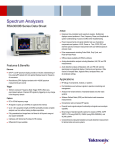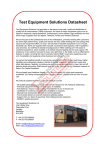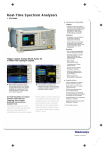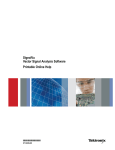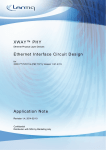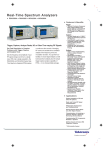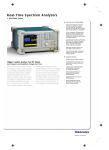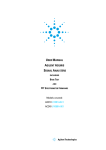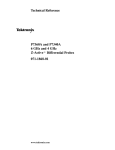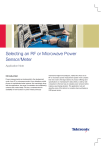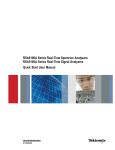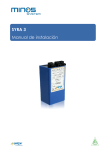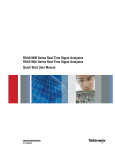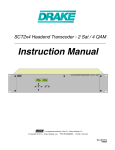Download Real-Time Spectrum Analyzer
Transcript
Real-Time Spectrum Analyzer RSA3408B Features & Benefits Discover DPX™ Spectrum Processing Provides an Intuitive Understanding of Time-varying RF Signals with Color Graded Displays Based on Frequency of Occurrence Revolutionary DPX Displays Transients with >48,000 Spectrum Measurements per Second Trigger Tektronix Exclusive Frequency Mask Trigger (FMT) Offers Easy Event-based Capture of Transient RF Signals by Triggering on Any Change in the Frequency Domain Capture DC to 8 GHz Frequency Range All Signals in Spans Up to 36 MHz are Captured into Memory RSA3408B DC to 8 GHz Real-Time Spectrum Analyzer with DPX™ The RSA3408B makes it easy for you to discover design issues that other signal analyzers miss. The revolutionary DPX™ spectrum display offers an intuitive live color view of signal transients changing over time in the frequency domain, giving you immediate confidence in the stability of your design or instantly displaying a fault when it occurs. This live display of transients is impossible with other signal analyzers. Once a problem is discovered with DPX, the RSA3408B Real-Time Spectrum Analyzer (RTSA) can be set to trigger on the event in the frequency domain, capture a continuous time record of changing RF events and perform time-correlated analysis in all domains. You get the functionality of a high-performance vector signal analyzer, a spectrum analyzer and the unique discover-trigger-capture-analyze capability of a Real-Time Spectrum Analyzer – all in a single package. Up to 1.28 s Acquisition Length at 36 MHz Bandwidth Provides Complete Analysis Over Time Without Making Multiple Acquisitions Fully Preselected and Image-free at all Times For Full Dynamic Range at any Capture Bandwidth Interfaces with TekConnect® Probes for RF Probing Differential IQ Input Available Analyze Revolutionary DPX display discovers what other analyzers miss. Here, a WLAN Access Point and Terminal are seen transmitting at different power levels. Frequency of occurrence is color-graded, indicating that the red AP is on more often than the blue terminal. Applications RF Debug of Components, Modules or Systems Find Interference and Unknown Signals in Spectrum Monitoring and Management Analyze Time-variant Behavior of Standards-based and Other Radio Systems Characterize Radar and Pulsed RF Signals Powerful Vector Signal Analyzer Functionality, Signal Source Analysis and RFID-standards Support Broad Range of Standard-specific Options for Analysis of 3GPP, 3GPP2, WiMax and WLAN Systems Extensive Time-correlated Multidomain Displays Connect Problems in Time, Frequency, Phase and Amplitude for Quicker Understanding of Cause and Effect when Troubleshooting Power Measurements and Signal Statistics Help You Characterize Components and Systems: ACLR, Power vs. Time, CCDF, PDF Pulse Measurements Including Pulse Width, Duty Cycle and Pulse-to-Pulse Phase Offline analysis available with RSAVu Software Real-Time Spectrum Analyzer RSA3408B Characteristics Discover The DPX spectrum processing engine brings live analysis of transient events to spectrum analyzers. Performing more than 48,000 frequency transforms per second, transients as brief as 31 µs are displayed in the frequency domain. This is orders of magnitude faster than conventional analysis techniques. Events are color-coded by rate of occurrence onto a bitmapped display, providing unparalleled insight into transient signal behavior. Trigger The Tektronix Frequency Mask Trigger (FMT, Opt. 02) makes it easy to trigger on signals in the frequency domain and capture transient signals in bandwidths up to a 36 MHz. An FMT is simply configured to monitor all changes in frequency occupancy within the capture bandwidth. The Power Trigger, working in any capture bandwidth, fires at the instant in time when the RF input signal crosses a user-set power threshold. An external trigger is available for synchronization to test system events. FMT and Spectrogram of WLAN/Bluetooth. A Frequency Mask Trigger was set to monitor the frequency domain for any changes in the spectrum, and it triggered on transient interference with a WLAN signal. The spectrogram shows the time relationship between the WLAN and transient signals, and the spectrum display shows what was happening at the precise moment the interfering signal was present in the band. FMT is an essential tool for separating known signals from unwanted interference. The RSA3408B is your best tool for both troubleshooting and conformance testing. Here, a mobile WiMax analysis is performed using RSA-IQWIMAX software. Capture Unlike many SA/VSA combination instruments, the RSA3408B is fully preselected at all times for spurious and image rejection in any combination of capture bandwidth and frequency. Capture of small signals in the presence of large signals is enabled with 73 dB Spurious-Free Dynamic Range (SFDR) and class-leading image rejection in all capture bandwidths. Capture once – make multiple measurements without recapturing. Record lengths vary depending upon the selected capture bandwidth-up to 1.28 seconds at 36 MHz, 51.2 seconds at 1 MHz or 1.42 hours at 10 kHz bandwidth with FMT/Deep Memory Option 02. Analyze The RSA3408B offers analysis capabilities that advance productivity for engineers working on components or in RF system design, integration and performance verification, or operations engineers working in network or spectrum management. Spectrograms display both frequency and amplitude changes over time. Measurements are Time-correlated across the frequency, phase, amplitude and modulation domains Analog modulation analysis and pulse analysis are standard 2 A wealth of modulation analysis options are available, including the UMTS W-CDMA Family (3GPP HSUPA and HSDPA), WiMax (Fixed and Mobile) and WLAN (802.11a/b/g/n). General purpose modulation analysis includes support for M-QAMs, QPSKs and the latest RFID standards including ISO 18000-7 and 15963, plus signal source analysis including phase noise, jitter, and frequency-settling time. See specifications for details on measurement options Powerful pulsed signal analysis for characterization of Radar and other pulsed systems. The RSA3408B automatically measures pulse width, rep rate, pulse power and 7 other pulse parameters. Accessories A wide range of Tektronix active and passive probes are supported with the RTPA2A probe adapter for your RSA3408B in circuit-troubleshooting applications. Probe calibration factors are transferred via USB for calibrated measurements. TekConnect Probe Supported P7225 P7240 P7260 P7330 P7350 P7350SMA P7380 P7380SMA P7313 Real-Time Spectrum Analyzers • www.tektronix.com/rsa Frequency Range Type 2.5 GHz 4 GHz 6 GHz 3.5 GHz 5 GHz 5 GHz 8 GHz 8 GHz >12.5 GHz Active Active Active Differential Differential Differential SMA Z-Active Differential Differential SMA Z-Active Differential Real-Time Spectrum Analyzer RSA3408B RSA3408B: The mid-range member of the RTSA Family Tektronix offers Real-Time Spectrum Analyzer models to meet a range of needs for frequency coverage, real-time bandwidth and dynamic range. The table below summarizes the differences between the models. Full details of the RSA3300B and RSA6100A models are available in separate data sheets. Specification or Feature Freq Range Max. Capture BW Triggers, Standard Triggers, Optional Digital Phosphor (DPX) Spectrum Update Rate, Max Span and Min. Signal Duration Memory Spurious-Free Dynamic Range at Max. Capture BW DANL, 1 GHz ACLR (3GPP 1 DPCH) SSB Phase Noise at Specified Offsets at 1 GHz, dBc/Hz (Typical) RSA3303/08B RSA3408B RSA6106/14A DC to 3.0/8.0 GHz 15 MHz Level, Free Run, External Frequency Mask 15 MHz BW >48,000 Spectrums/sec 15 MHz Max Span Min. Sig. Duration: 41 us 64M/256MB –70 dBc/15 MHz DC to 8.0 GHz 36 MHz Level, Free Run, External Frequency Mask 36 MHz BW >48,000 Spectrums/sec 36 MHz Max Span Min. Sig. Duration: 31 us 64M/256MB –73 dBc/36 MHz 9 kHz to 6.2/ 14.0 GHz 40 MHz standard 110 MHz Option Level, Free Run, External(2), Line Frequency Mask 40/110 MHz BW >48,000 Spectrums/sec 40/110 MHz Max Span Min. Sig. Duration: 31/24 us 256M/1 GB –73 dBc/110 MHz –150 dBm/Hz 66 dB 10 kHz: –108 1 MHz: –133 10 MHz: –136 8.4 Inch Screen, Keyboard, Mouse, Front Panel GPIB, LAN, USB(2) Internal HDD, FDD 20 MHz BW Differential Inputs Not Available Not Available –151 dBm/Hz 72 dB 10 kHz: –112 1 MHz: –135 10 MHz: –140 8.4 Inch Screen, Keyboard, Mouse, Front Panel GPIB, LAN, USB(2) Internal HDD, FDD Optional Removable HDD 40 MHz BW Differential Inputs Standard, 421 MHz, 40 MHz BW Up to 36 MHz BW Option, External, 0.1 to 3 GHz 20 dB Gain nominal Option, External, 0.1 to 3 GHz 20 dB Gain nominal –149 dBm/Hz 79 dB 10 kHz: –110 1 MHz: –134 10 MHz: –142 10.4 Inch Touch-Screen, Keyboard, Mouse, Front Panel GPIB, LAN, USB(4) Internal HDD, DVD ±RW Optional Removable HDD Not Available Option, 500 MHz, 120 MHz BW Up to 110 MHz BW, fully corrected amplitude and phase Option, Internal, 0.01 to 3 GHz 30 dB Gain nominal Screen Size, User Interface Interface Ports Storage Media IQ Inputs Option IF Outputs Digital I and Q Output Option Bandwidth Preamplifier Trigger-related Trigger Modes – Free run, Triggered (Single or Continuous). Trigger Event Source – RF Input, External Trigger Input. Trigger Types – Power Level: Frequency Mask (Opt. 02). Trigger Position – settable from 0 to 100% of total acquisition length. Power Level Trigger Level Range – 0 dBfs to –40 dBfs*1 from reference level. Trigger Bandwidth Range – 100 Hz to 36 MHz (equal to selected span). Trigger Position Display Timing Uncertainty (Power and External Trigger) – ±2 sample points. *1 dBfs: dB relative to full scale. Frequency Mask Trigger (Option 02) Mask Shape – User-defined. Mask Point Horizontal Resolution – 1 bin. Level Range – 0 to –60 dBfs at 10 dB/div vertical scale. Level Accuracy – Equal to reference level accuracy + frequency response over 0 to –60 dBfs range. Span Range Start Frequency ≥ 40 MHz – 100 Hz to 36 MHz. Start Frequency < 40 MHz – 100 Hz to 40 MHz. Minimum Event Duration for 100% Probability of Trigger – 20 µs (at maximum acquisition bandwidth) Events lasting less than minimum event duration specification will result in degraded Frequency Mask Trigger level accuracy. Trigger Position Uncertainty – ± 2 Frames (For Span = 36 MHz, uncertainty = ±40 µs). External Trigger Level Range – –1.5 V to +1.5 V. Level Setting Resolution – 0.1 V. Trigger Position Timing Uncertainty – ± 2 Samples. Input Impedance – > 2K Ω (nominal). Trigger Output Voltage HIGH – ≥ 2.0 V; LOW – <0.4 V (Output Current <1 mA). Capture-related Real-Time Acquisition Bandwidth, maximum Start Frequency ≥ 40 MHz (RF) – 36 MHz. Start Frequency <40 MHz (Baseband) – 40 MHz. IQ Inputs (Option 03) – 40 MHz. A/D Converter – 102.4 MS/s, 14 bit. Acquisition Memory Size – 64 MB (16.4 MSamples) Standard, 256 MB (65.6 MSamples), Opt. 02. Minimum Acquisition Length – 1024 Samples. Acquisition Length Setting Resolution – 1024 Samples. Real-Time Spectrum Analyzers • www.tektronix.com/rsa 3 Real-Time Spectrum Analyzer RSA3408B Memory Depth (time) and Maximum Time Resolution Span 40 MHz (baseband) 36 MHz 20 MHz 10 MHz 5 MHz 2 MHz 1 MHz 500 kHz 200 kHz 100 kHz 50 kHz 20 kHz 10 kHz 5 kHz 2 kHz 1 kHz 500 Hz 200 Hz 100 Hz Sample Rate Record Length Record Length Spectrum Frame Time Resolution (For I and Q) Standard (Option 02) (Time) (I and Q) 51.2 MS/s 51.2 MS/s 25.6 MS/z 12.8 MS/s 6.4 MS/s 2.56 MS/s 1.28 MS/s 640 kS/s 256 kS/s 128 kS/s 64 kS/s 25.6 kS/s 12.8 kS/s 6.4 kS/s 2.56 kS/s 1.28 kS/s 640 S/s 256 S/s 128 S/s 0.32 s 0.32 s 0.64 s 1.28 s 2.56 s 6.4 s 1.28 s 25.6 s 64 s 128 s 256 s 640 s 1280 s 2560 s 6400 s 12800 s 25600 s 64000 s 128000 s 1.28 s 1.28 s 2.56 s 5.12 s 10.24 s 25.6 s 51.2 s 102.4 s 256 s 512 s 1024 s 2560 s 5120 s 10240 s 25600 s 51200 s 102400 s 256000 s 512000 s 20 µs 20 µs 40 µs 80 µs 160 µs 400 µs 800 µs 1.6 ms 4.0 ms 8.0 ms 16 ms 40 ms 80 ms 160 ms 400 ms 800 ms 1.6 s 4.0 s 8.0 s 20 ns 20 ns 40 ns 80 ns 160 ns 400 ns 800 ns 1.6 µs 4.0 µs 8.0 µs 16 µs 40 µs 80 µs 160 µs 400 µs 800 µs 1.6 ms 4 ms 8 ms Analysis-related Standard Measurement Functions by Mode Spectrum Analyzer Mode – Channel Power, Adjacent Channel Power, Occupied Bandwidth, Emission Bandwidth, Carrier-to-Noise Ratio, Carrier Frequency, Spurious Search, dBm/Hz Marker, dBc/Hz Marker. RTSA Mode – Channel Power, Adjacent Channel Power, Occupied Bandwidth, Emission Bandwidth, Carrier-to-Noise Ratio, Carrier Frequency, Spurious Search, dBm/Hz Marker, dBc/Hz Marker. RTSA with Zoom – dBm/Hz Marker, dBc/Hz Marker DPX – dBm/Hz Marker, dBc/Hz Marker. Analog Mod. Analysis – IQ vs. Time, AM Depth, FM Deviation, PM, Pulse Spectrum. Time – IQ vs. Time, Power vs. Time, Frequency vs. Time, CCDF, Crest Factor. Pulse – Pulse Width, Peak Power, Ripple, Pulse Repetition Interval, Duty Cycle, Pulse-to-Pulse Phase, Frequency Deviation, Channel Power, OBW, EBW. Optional Measurement Functions, Standards-based and Offline Analysis*2 General Purpose Digital Modulation Analysis (Option 21) Mod. Formats: BPSK, QPSK, π/4 DQPSK, OQPSK, 8PSK, 16/32/64/128/256-QAM, GMSK, GFSK, C4FM, 2ASK, 2FSK. Standard support: Bluetooth, TETRA, P25, 802.15.4 – EVM (RMS, Peak, EVM vs. Time), Magnitude Error (RMS, Peak, Mag Error vs. Time), Phase Error (RMS, Peak, Phase Error vs. Time), Origin Offset, Frequency Error, Gain Imbalance, Quadrature Error, Rho (ρ), Constellation, Symbol Table, PDF: Probability of Occurrence vs. Power Level – AM-AM, AM-PM, 1 dB Compression, Crest Factor. RFID Analysis(Included in Option 21) ISO/IEC 18000 Part 4 Mode 1. ISO/IEC 18000 Part 6 Type A, B, C. ISO/IEC 18092(424k). ISO/IEC 14443 Part 2 Type A, B. EPC Global Generation 1 Class 0, Class 1. ISO/IEC 18000-7 ISA/IEC 15693 – Maximum ERP, Spurious, Power-on and Power-down Timing and Settling, RF Envelope On-Width, OffWidth and Period, Constellation, Modulation Depth, Modulation Index, Symbol Rate, Bit Rate, Tari Data 0, Tari Data - 1, Eye Diagram, Symbol Table, OBW, EBW, FSK Envelope. Signal Source Analysis (Included in Option 21) – Integrated Phase Noise, Random Jitter, Periodic Jitter, Settling Time, Spurious, Real-Time Phase Noise vs. Time (Noise-o-gram). GSM/EDGE (Option 24) – Modulation Accuracy, Mean Power, Power vs. Time, Spectrum due to Modulation, Spectrum due to Switching. CDMA2000-1X Forward/Reverse Link (Option 25) – Channel Power,ACPR, Spectrum Emission Mask, CCDF, Modulation Accuracy, Code Domain Power. 1XEV-DO Forward/Reverse Link (Option 26) – Channel Power, ACPR, Spectrum Emission Mask, CCDF, Modulation Accuracy, Code Domain Power. TD-SCDMA (Option 28) – Channel Power, ACLR, CCDF, Modulation Accuracy, Code Domain Power. 802.11 a/b/g/n (Option 29) – Transmit Power, Spectrum Mask, Modulation Accuracy, OFDM Flatness and Linearity, 802.11n Transfer Function, Transfogram, Delay Profile, Delayogram, Transfer Efficiency. 3GPP W-CDMA Release 5 HSDPA (Option 30) – Channel Power, ACLR, Spectrum Emission Mask, CCDF, Modulation Accuracy, Code Domain Power, PRACH, ACK/NACK Analysis. *2 See separate data sheets for specifications. 4 Real-Time Spectrum Analyzers • www.tektronix.com/rsa 3GPP Release 6 HSUPA (Option 40) – Channel Power, ACLR, Spectrum Emission Mask, CCDF, Modulation Accuracy, Code Domain Power, Phase Discontinuity, E-RGCH, E-HICH, E-AGCH Analysis. RSA-IQWiMax Analysis Software – Spectrum Mask, Spectral Flatness, Symbol Constellation, Pilot Phase Error, Frequency Error, EVM vs. Carrier, EVM vs. Time. Offline Analysis RSAVu – All measurements that can be performed on a stored waveform can be performed with RSAVu offline analysis software (except TD-SCDMA, Option 28). Spectrum Mode Display Traces, Detectors and Functions Traces – Two traces. Detector – Max, Min, Max-Min. Trace Functions – Normal,Average, Max Hold, Min Hold. Spectrum Trace Length – 801 points (Auto mode). Real-Time Spectrum Analyzer RSA3408B RF Performance Frequency Resolution (RTSA Mode and FFT Analysis in Spectrum Mode) Resolution BW Range vs. Span (DPX) Frequency Range – DC to 8 GHz. Initial Center Frequency Setting Accuracy – within 10–7 after 10 minute warm-up. Center Frequency Setting Resolution – 0.1 Hz. Frequency Marker Readout Accuracy – <40 MHz ± (RE x MF + 0.001 x Span + 0.2) Hz. ≥ 40 MHz ± (RE x MF + 0.001 x Span + 2) Hz. Note: RE: Reference Frequency Error, MF: Marker Frequency (Hz) Span Accuracy – ±0.3% (Auto mode). Reference Frequency – Aging per Day – 1 x 10–9 (after 30 days of operation). Aging per Year – 1 x 10–7 (after 30 days of operation). Temperature Drift – 1 x 10–7 (10 to 40 ºC). Total Frequency Error – 2 x 10–7 (within one year after calibration). Reference Output Level – > 0 dBm. External Reference Input Frequency – 10 MHz. External Reference Input Level Range – –10 dBm to + 6 dBm, Spurious level must be < –80 dBc within 100 kHz offset. Noise Bandwidth Range, RTSA Mode – 0.250545 Hz to 100.218 kHz. FFT Performance, Spectrum Mode – Number of samples per frame : 64 to 8192 (65,536 samples per frame, extended resolution). Window types – Rectangular, Parzen, Welch, Sine-Lobe, Hanning, Sine-Cubed, Sine-to-the 4th, Hamming, Blackman, Rosenfield, Blackman-Harris 3A, Blackman-Harris 3B, Blackman-Harris 4A, Blackman-Harris 4B, FlatTop. Acquisition Bandwidth 36 MHz 20 MHz 10 MHz 5 MHz 2 MHz 1 MHz 500 kHz 200 kHz 100 kHz 50 kHz 20 kHz 10 kHz 5 kHz 2 kHz 1 kHz 500 Hz 200 Hz 100 Hz Resolution Bandwidth (Spectrum Analysis Mode) Stability Frequency Resolution Bandwidth Range – 1 Hz to 10 MHz (auto-coupled or user-selected (arbitrary)). Resolution Bandwidth Shape – 1 Hz to 10 MHz. Approximately Gaussian, shape factor <5:1 (60:3 dB) typical. Rectangular, Nyquist and Root Nyquist shapes may also be selected. Resolution Bandwidth Accuracy – Within 6% (referenced to –3 dB BW). ±0.1% (referenced to Noise BW). Minimum Settable Spectrum Analysis RBW vs. Span Extended Resolution ON Frequency Span > 2 GHz > 1 GHz to 2 GHz >500 MHz to 1 GHz >20 MHz to 500 MHz >500 kHz to 20 MHz >200 kHz to 500 kHz >100 kHz to 200 kHz >50 kHz to 100 kHz >20 kHz to 50 kHz >10 kHz to 20 kHz >5 kHz to 10 kHz >2 kHz to 5 kHz >1 kHz to 2 kHz >100 Hz to 1 kHz DPX Digital Phosphor Spectrum Processing Spectrum Processing Rate – 48,000/s, spanindependent. Number of Traces – 2. Trace Types – Color-graded bit map, +Peak, Max Hold, –Peak, Min-Hold, Average. Minimum Signal Duration for 100% Probability of Intercept – 31 µs. Span Range – 100 Hz to 36 MHz. Resolution BW Accuracy –7%. RBW (Min) 300 kHz 200 kHz 100 kHz 30 kHz 20 kHz 10 kHz 5 kHz 2 kHz 1 kHz 500 Hz 200 Hz 100 Hz 30 Hz 20 Hz 10 Hz 3 Hz 2 Hz 1 Hz Residual FM – < 2 Hz p-p, typical Phase Noise Sidebands, dBc/Hz at Specified Center Frequency (CF) Offset 1 kHz 10 kHz 100 kHz 1 MHz 5 MHz 10 MHz CF = 1 GHz CF = 2 GHz CF = 6 GHz Spec Typical Spec Typical Spec Typical –105 –110 –112 –132 –138 –138 –107 –112 –115 –135 –140 –140 –103 –109 –112 –132 –138 –138 –105 –111 –115 –135 –140 –140 –97 –106 –111 –132 137 137 –99 –108 –113 –134 –139 –139 RBW 100 kHz 50 kHz 20 kHz 10 kHz 1 kHz 500 Hz 200 Hz 100 Hz 50 Hz 20 Hz 10 kHz 5 Hz 2 Hz 1 Hz Real-Time Spectrum Analyzers • www.tektronix.com/rsa 5 Real-Time Spectrum Analyzer RSA3408B Amplitude (Specifications excluding mismatch error) Measurement Range – Displayed Average Noise Level to Maximum Safe Input. Input Attenuator Range RF/Baseband input – 0 dB to 55 dB, 5 dB step. IQ Input (Opt 03) – 0 dB to 35 dB, 5 dB step. Maximum Safe Input Level – Average Continuous (RF Band, RF ATT ≥10 dB) – +30 dBm. MAX DC Voltage – RF Band, ±0.2 V, Baseband, ±5 V, IQ input, Opt. 03. ±5 V. Maximum Measurable Input Level – Average Continuous (RF ATT: Auto): +30 dBm. Log Display Scale – 10 µdB/div to10 dB/div. Display Divisions – 10 divisions. Display Units – dBm, dBµV, Volts, Watts, Hz for Frequency Measurements, and Degrees for Phase Measurements. Marker Readout Resolution, dB units – 0.01 dB. Marker Readout Resolution, Volts units – 0.001 µV. Reference Level Setting Range RF – –50 dBm to +30 dBm, 1 dB step. Baseband – –30 dBm to +20 dBm, 5 dB step. IQ Inputs (Option 03) – –10 dBm to +20 dBm, 5 dB step. Level Linearity over Display Range – ±0.2 dB, spec; ±0.12 dB, typical. Frequency Response (20 ºC to 30 ºC, Att. ≥ 10 dB) Frequency 100 kHz to 40 MHz > 40 MHz to 3.5 GHz > 3.5 GHz to 6.5 GHz > 6.5 GHz to 8 GHz Spec ±0.5 dB ±1.2 dB ±1.7 dB ±1.7 dB Typical ±0.3 dB ± 0.5 dB ± 1.0 dB ± 1.0 dB Amplitude Accuracy (–20 dBm signal, 0 dB ATT, 20 ºC to 30 ºC) Absolute Amplitude Accuracy at Calibration Point. RF (100 MHz) – ±0.5 dB. Baseband (25 MHz) – ±0.3 dB. Input Attenuator Setting Uncertainty – ±0.2 dB. Reference Level Accuracy (–10 dBm to –50 dBm at 100 MHz) – ±0.2 dB. VSWR – (Att ≥ 10 dB, Preamp OFF), Typical, < 1.4:1 (300 kHz to 40 MHz), < 1.3:1 (40 MHz to 3 GHz), < 1.4:1 (3 GHz to 8 GHz). 6 Distortion 3rd Order Inter-modulation Distortion – (Total Signal Power = –7 dBm, Ref Level +5 dBm, Attenuator adjusted for optimum performance). Frequency – 3rd order IM. 2.0 GHz – < –78 dBc. 2nd Harmonic Distortion (–30 dBm tone at input mixer) Frequency – 2nd Harmonic Distortion, Typical, 10 MHz to 1.4 GHz – < –65 dBc, 1.4 GHz to 1.75 GHz – <–70 dBc. Displayed Average Noise Level (input terminated) Frequency 1 kHz to 10 kHz > 10 kHz to 100 MHz > 100 MHz to 3 GHz >3 GHz to 8 GHz Preamp (Opt. 01A) Performance (Typical) Frequency Range Specification –144 dBm/Hz –151 dBm/Hz –150 dBm/Hz –142 dBm/Hz 100 MHz to 3 GHz 20 dB gain, 6.5 dB Noise Figure at 2 GHz Residual Response (Input Terminated, Ref. Level=–30 dBm, RBW = 100 kHz) Frequency and Span Specification 1 MHz to 40 MHz, Span 20 MHz –93 dBm 0.5 GHz to 3.5 GHz, Span 3 GHz –90 dBm 3.5 GHz to 8 GHz, Span 3 GHz –85 dBm Spurious Response with Signal (Signal at Center Frequency, Span=10 MHz, Ref Lvl=0 dBm, RBW=50 kHz, Signal Level= –5 dBm). Signal Frequency 25 MHz 2 GHz 5 GHz 5 GHz Spurious Response –73 dBc –73 dBc –70 dBc –70 dBc Real-Time Spectrum Analyzers • www.tektronix.com/rsa Adjacent Channel Leakage Ratio Dynamic Range (Typical, CF = 2.1425 GHz, with test signal amplitude adjusted for optimum performance). Signal Type, Measurement Mode 3GPP Downlink, 1 DPCH Real-time (Spec.) Stepped (Typical) ACLR Adjacent Alternate –66 dB –68 dB –70 dB –72 dB IF Frequency Response and IF Phase Linearity – (400 MHz Center Frequency, 36.6 MHz BW, Typical). Amplitude – ±0.3 dB. Phase – ±2.5º. Analog Modulation Analysis Displays Amplitude vs. Time, Frequency vs. Time, Phase vs. Time Measurements AM FM +AM, – AM, Total AM, Modulation Depth +peak, –peak, peak-to-peak, (peak-topeak)/2, rms PM Phase at marker Accuracy (–10 dBfs signal, input at CF, typical) AM ±2% (modulation depth 10% to 60 %) FM ±1% of span PM ±3º Pulse Measurements Displays – Pulse Measurement Table, Pulse Trace. Measurements – Pulse Width, Pulse Peak Power, On/Off Ratio, Pulse Ripple, Pulse Repetition Interval, Duty Cycle, Pulse-Pulse Phase, Channel Power, OBW, EBW, Frequency Deviation. Minimum Pulse Width for Detection – 20 samples (400 ns@maximum sample rate). Maximum Pulse Length – 260,000 samples. Real-Time Spectrum Analyzer RSA3408B Inputs and Outputs Front Panel RF and Baseband Input Connector – N type, 50 Ω. I and Q Inputs (Option 03) – BNC Type. Preamp Power Connector – Lemo, 6 poles: pin 1 = NC. pin 2 = ID1. pin 3 = ID2. pin 4 = –12 V. pin 5 = GND. pin 6 = +12 V. Rear Panel Analog IF Output – BNC Type, Frequency – 421 MHz. 10 MHz REF OUT – 50 Ω, BNC, > –3 dBm. 10 MHz REF IN – 50Ω, BNC, –10 dBm to +6 dBm. EXT TRIG IN – Ext Trig, BNC, High: 1.6 to 5.0 V, Low: 0 to 0.5 V. GPIB Interface – IEEE 488.2. Trigger Out – 50 Ω, BNC, High >2.0 V, Low: <0.4 V (output current 1 mA). Digital IQ Output (Option 05) Connector Type – MDR (3M) 50 pin x 2. Data Output I data – 16 bit LVDS. Q data – 16 bit LVDS. Control Output – Clock: LVDS, MAX 51.2 MHz. Control Input – IQ data output enabled, connecting GND enables output of IQ data. Clock Rising Edge to Data Transition Time (hold time) – > 5 ns. Data Transition to Clock Rising Edge (setup time) – > 5 ns. Note: Data from Option 05 requires application of correction factors to IQ data to achieve similar RF performance to RSA3408A. Side Panel LAN Interface Ethernet – 10/100Base-T. Serial Interface – USB 1.1, two ports. VGA Output – VGA compatible, 15 DSUB. Floppy Disk Drive – 3.5 inch, 1.44 MB. General Characteristics Ordering Information RSA3408B Real-Time Spectrum Analyzer, DC – 8 GHz. Includes: User Manual, Programmer’s Manual (On CD), Power Cord, BNC-N Adapter, USB Keyboard, USB Mouse, Front Cover. Temperature Range Operating – +10º C to +40º C. Storage – –20º C to +60º C. Warm-up Time – 20 minutes. Operating Altitude Operating – up to 3000 m (Approximately 10,000 ft.). Non-operating – up to 12,190 m (40,000 ft.). Safety and Electromagnetic Compatibility – UL 61010-1; CSA C22.2 No. 61010-1-04. IEC61010, second edition (Self Declaration). Low Voltage Directive 2006/95/EC; EN61010-1: 2001 Safety requirements for electrical equipment for Measurement control and laboratory use. EC Council EMC Directive 2004/108/EEC;EN61326: 1997 Product Family Standard for Electrical Equipment for Measurement, Control, and Laboratory Use-EMC Requirements. Radiocommunications Act:1992, EMC Regulatory Arrangements, AS/NZS CISPR 11 (Industrial, Scientific and Medical Equipment). Power Requirements – 90 VAC to 264 VAC, 47 Hz to 63 Hz. Power Consumption – 400 VA maximum. Data Storage – Internal HDD, USB ports, FDD, Removable HDD (Opt. 06). Weight, with all options – 20 kg (44 lbs.). Dimensions (mm, in) Without bumpers and feet – 215 mm (H) x 425 mm (D) x 425 mm (W). With bumpers and feet – 238 mm (H) x 470 mm (D) x 445 mm (W). Calibration Interval – One year. Warranty – One year. GPIB – SCPI-compatible, IEEE488.2 compliant. Options – Description Opt 1A – Preamp, External, 0.1 to 3 GHz, 20 dB Gain, 6.5 dB NF. Opt 02 – 65.5 Msample Deep Memory, Frequency Mask Trigger. Opt 03 – IQ, Differential IQ inputs. Opt 05 – Digital IQ Output. Opt 06 – Removable HDD (40 GB). Opt 21 – Advanced Measurements Suite (GP Mod. Analysis, RFID, Sig. Source). Opt 24 – GSM/EDGE Analysis. Opt 25 – CDMA 1X Forward/Reverse Link Analysis. Opt 26 – 1X EVDO Forward/Reverse Link Analysis. Opt 28 – TD-SCDMA Analysis. Opt 29 – WLAN 802.11a/b/g/n Analysis. Opt 30 – 3GPP Release 99 (W-CDMA) and Release 5 UL/DL (HSDPA) Analysis. Opt 40 – 3GPP Release 6 (HSUPA UL/DL) Analysis (requires opt 30). Real-Time Spectrum Analyzers • www.tektronix.com/rsa 7 Contact Tektronix: ASEAN / Australasia (65) 6356 3900 Real-Time Spectrum Analyzer Austria +41 52 675 3777 RSA3408B Balkans, Israel, South Africa and other ISE Countries +41 52 675 3777 Belgium 07 81 60166 Brazil & South America (11) 40669400 Application Software and Accessories Upgrades RSA-IQWIMAX – LitePoint IQsignalTM Software for Tektronix Real-Time Spectrum Analyzers. Extra Hard Drive – Extra 40 GB Removable Hard Drive for use with Opt. 06. Order part number 065-0802-007. RSA3KR Rackmount – Rackmount RSA33/34B Series Real Time Spectrum Analyzers (customer installable). RTPA2A – Adapter for use with TekConnect Active and Passive Probes. E and H Near-field probes – For EMI troubleshooting. Order part number 119-4146-00. Preamp, External – 0.1 to 3 GHz, 20 dB Gain, 6.5 dB NF. Order part number 672-A900-00. RSA34BUP International Power Plugs Opt A0 – North America. Opt A1 – Universal EURO. Opt A2 – United Kingdom. Opt A3 – Australia. Opt A4 – 240V North America. Opt A5 – Switzerland. Opt A6 – Japan. Opt A10 – China. Opt A11 – India. Opt A99 – No Power Cord or AC Adapter. Manuals – Order Number Additional User Manual (Paper, English) – 071-2364-00. Additional User Manual (Paper, Japanese) – 071-2365-00. Service Manual (Paper, English) – 071-2366-00. Operator Manual (Paper, Russian) – 071-2369-00. Service Options Opt CA1 – Provides a single calibration event or coverage for the designated calibration interval, whichever comes first. Opt C3 – Calibration Service 3 Years. Opt C5 – Calibration Service 5 Years. Opt D1 – Calibration Data Report. Opt D3 – Calibration Data Report 3 Years (with Option C3). Opt D5 – Calibration Data Report 5 Years (with Option C5). Opt R3 – Repair Service 3 Years (including warranty). Opt R5 – Repair Service 5 Years (including warranty). Canada 1 (800) 661-5625 Central East Europe, Ukraine and the Baltics +41 52 675 3777 Option Central Europe & Greece +41 52 675 3777 Denmark +45 80 88 1401 Opt 1A – Preamp, External, 0.1 to 3 GHz, 20 dB Finland +41 52 675 3777 Gain, 6.5 dB NF (customer-installable). France +33 (0) 1 69 86 81 81 Opt 02 – 65.5 MSample Deep Memory, Frequency Germany +49 (221) 94 77 400 Mask Trigger (customer installable). Hong Kong (852) 2585-6688 Opt 03 – IQ, Differential IQ inputs India (91) 80-22275577 (customer-installable). Italy +39 (02) 25086 1 Opt 05 – Digital IQ Output (customer-installable). Japan 81 (3) 6714-3010 Opt 06 – Removable HDD. Luxembourg +44 (0) 1344 392400 Opt 21 – Advanced Measurements Suite (customer-installable). Mexico, Central America & Caribbean 52 (55) 5424700 Opt 24 – GSM/EDGE Analysis (customer-instalMiddle East, Asia and North Africa +41 52 675 3777 lable). The Netherlands 090 02 021797 Opt 25 – CDMA 1X Forward/Reverse Link Analysis Norway 800 16098 (customer-installable). People’s Republic of China 86 (10) 6235 1230 Opt 26 – 1X EVDO Forward/Reverse Link Analysis Poland +41 52 675 3777 (customer-installable). Portugal 80 08 12370 Opt 28 – TD-SCDMA Analysis (customer-installable). Opt 29 – WLAN 802.11a/b/g/n Analysis (customerRepublic of Korea 82 (2) 6917-5000 installable). Russia & CIS +7 (495) 7484900 Opt 30 – 3GPP Release 99 (W-CDMA) and Release South Africa +27 11 206 8360 5 (W-CDMA) UL/DL Analysis (customer-installable). Spain (+34) 901 988 054 Opt 40 – 3GPP Release 6 (HSUPA UL/DL) Analysis Sweden 020 08 80371 (requires opt 30, customer-installable). Switzerland +41 52 675 3777 Opt IF – Installation labor for RSA34BUPxx (no caliTaiwan 886 (2) 2722-9622 bration required). Opt IFC – Installation labor for RSA34BUPxx (with United Kingdom & Eire +44 (0) 1344 392400 calibration). USA 1 (800) 426-2200 Languages Opt L0 – English Users/ Programmers Manual. Opt L5 – Japanese Users/ Programmers Manual. Opt L10 – Russian Manual. For other areas contact Tektronix, Inc. at: 1 (503) 627-7111 Updated 12 November 2007 For Further Information Tektronix maintains a comprehensive, constantly expanding collection of application notes, technical briefs and other resources to help engineers working on the cutting edge of technology. Please visit www.tektronix.com Product(s) are manufactured in ISO registered facilities. Product(s) complies with IEEE Standard 488.1-1987, RS-232-C, and with Tektronix Standard Codes and Formats. Copyright © 2007, Tektronix. All rights reserved. Tektronix products are covered by U.S. and foreign patents, issued and pending. Information in this publication supersedes that in all previously published material. Specification and price change privileges reserved. TEKTRONIX and TEK are registered trademarks of Tektronix, Inc. All other trade names referenced are the service marks, trademarks or registered trademarks of their respective companies. 12/07 HB/WOW 37W-21129-0








